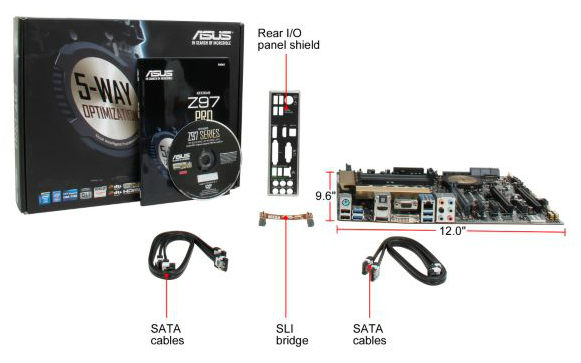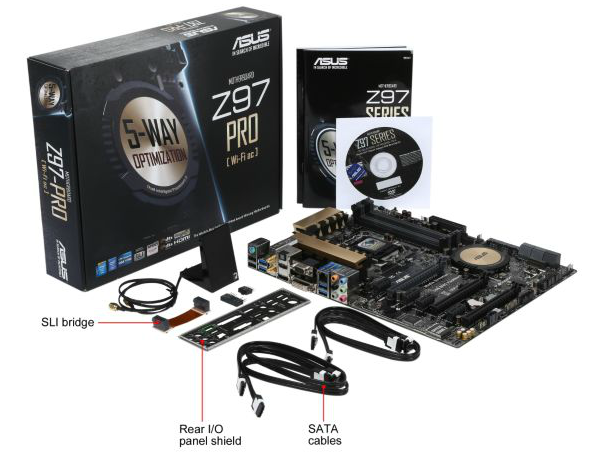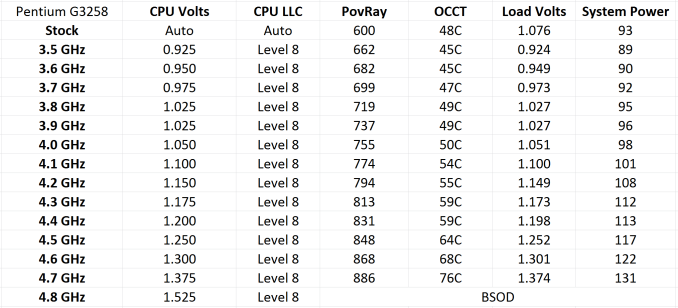ASUS Z97-Pro WiFi AC Review
by Ian Cutress on July 16, 2014 10:00 AM EST- Posted in
- Motherboards
- Asus
- Haswell
- 802.11ac
- Z97
ASUS Z97-Pro WiFi AC In The Box
As mentioned previously, this motherboard is available in two versions: with or without the WiFi module. The price difference goes towards the module and the antenna, with the rest of the package being the same. Being $188 and $200, one might imagine that motherboards in this price bracket bring something extra into the package, however the dynamic for 9-series seems to have changed. Previously with two USB 3.0 headers, one might expect a USB 3.0 bracket, but now we have cases with two USB 3.0 connectors for four ports on the case, so motherboard manufacturers are avoiding this add-on. With the mainstream series also, there is not much incentive to go beyond a flexi-SLI bridge unless the motherboard uses a PLX 8747 chip for 3x or 4x SLI. Because SATA Express is now here, one might imagine that SATAe cables will start being part of the package, but a lack of drives on the market is stagnating this advancement.
In the Z97-Pro package we have:
Driver Disk
Manual
Rear IO Shield
Four SATA Cables
Flexi SLI Bridge
Q-Connectors
WiFi Antenna (WiFi AC version only)
With a total of 8 SATA ports (two being part of SATAe), only four SATA cables may cover most users but not all. The WiFi antenna is ASUS’ rotating design, although I personally preferred the older magnetic ring antennas.
ASUS Z97-Pro WiFi AC Overclocking
Experience with ASUS Z97-Pro WiFi AC
The Z97-Pro has formed the bedrock of my Haswell Refresh and Devil’s Canyon CPU test bed since the 9-series was released, and there has not been much to worry about. With the Devil’s Canyon CPUs, both the i5 and i7 saw 4.7 GHz, as did the Pentium G3258.
For our regular i7-4770K testing CPU, the automatic overclocking provided by the 5-Way Optimization software gave 4.7 GHz for single core loading and 4.6 GHz for multi-core, Unfortunately the voltage was set to 1.250V in adaptive mode, which causes extra voltage as the speed is ramped up. As a result, the overclock caused the system to reduce its performance when it got too hot, giving a POV-Ray score equivalent to around 4125 MHz.
Methodology
Our standard overclocking methodology is as follows. We select the automatic overclock options and test for stability with PovRay and OCCT to simulate high-end workloads. These stability tests aim to catch any immediate causes for memory or CPU errors.
For manual overclocks, based on the information gathered from previous testing, starts off at a nominal voltage and CPU multiplier, and the multiplier is increased until the stability tests are failed. The CPU voltage is increased gradually until the stability tests are passed, and the process repeated until the motherboard reduces the multiplier automatically (due to safety protocol) or the CPU temperature reaches a stupidly high level (100ºC+). Our test bed is not in a case, which should push overclocks higher with fresher (cooler) air.
Overclock Results
For the i7-4770K, we achieved the following:
46x at 1.325V is pretty much where we expected to be with our CPU sample. The limiting factor in our testing here is the average CPU, meaning that temperature is artificially making a ceiling.
For other CPUs:
Test Setup
| Test Setup | |
| Processor |
Intel Core i7-4770K ES 4 Cores, 8 Threads, 3.5 GHz (3.9 GHz Turbo) |
| Motherboard | ASUS Z97-Pro |
| Cooling |
Corsair H80i Thermalright TRUE Copper |
| Power Supply |
OCZ 1250W Gold ZX Series Corsair AX1200i Platinum PSU |
| Memory | G.Skill RipjawsZ 4x4 GB DDR3-1600 9-11-9 Kit |
| Memory Settings | 1600 9-11-9-27 1T tRFC 240 |
| Video Cards |
MSI GTX 770 Lightning 2GB (1150/1202 Boost) ASUS HD7970 3GB (Reference) |
| Video Drivers |
Catalyst 13.12 NVIDIA Drivers 335.23 |
| Hard Drive | OCZ Vertex 3 256GB |
| Optical Drive | LG GH22NS50 |
| Case | Open Test Bed |
| Operating System | Windows 7 64-bit SP1 |
| USB 2/3 Testing | OCZ Vertex 3 240GB with SATA->USB Adaptor |
Many thanks to...
We must thank the following companies for kindly providing hardware for our test bed:
- Thank you to OCZ for providing us with PSUs and SSDs.
- Thank you to G.Skill and ADATA for providing us with memory kits.
- Thank you to Corsair for providing us with an AX1200i PSU, Corsair H80i CLC and DRAM.
- Thank you to ASUS for providing us with the AMD HD7970 GPUs and some IO Testing kit.
- Thank you to MSI for providing us with the NVIDIA GTX 770 Lightning GPUs.
- Thank you to Rosewill for providing us with PSUs and RK-9100 keyboards.
- Thank you to ASRock for providing us with some IO testing kit.
















38 Comments
View All Comments
DanNeely - Wednesday, July 16, 2014 - link
Where're you finding it for <$200? Newegg has it at $219. The shopping search in the where to buy link picks up several lower spec models in the same family.owan - Wednesday, July 16, 2014 - link
Reading all these z97 reviews only underscores how badly intel needs to increase the number of available PCIe lanes, particularly the 3.0 lanes off the CPUGigaplex - Wednesday, July 16, 2014 - link
That's why Intel has the enthusiast socket 2011 platform.DanNeely - Friday, July 18, 2014 - link
Unfortunately Intel's kept it crippled by delaying the enthusiast CPUs using it until they complete all the extra testing/validation they claim is needed for Xeons but not regular consumer parts. If they'd release the enthusiast parts at about the same time as the mass market ones and then the Xeon's a year later it'd get much more respect. As it stands, it's basically just smoke and mirrors.rchris - Wednesday, July 16, 2014 - link
Appreciate the fine review. However, I really wish product reviews would include some data or sampling of the manufacturer's customer service performance. I know there are feedback comments on sites such as Newegg.com, but they are all horror stories and it's hard to tell if they represent what typically happens when you get a lemon and have to deal with it.ggathagan - Wednesday, July 16, 2014 - link
What would be better would be an investigative article that dealt solely with the quality of customer service from all the manufacturers over a period of, say 2-3 months.There are only a handful of motherboard providers. To add this to every review would be needlessly redundant.
Customer service tends to be quite hit-or-miss, since so much of it depends on the individual who takes your call.
Farwalker2u - Wednesday, July 16, 2014 - link
Hysteresis, the dependence of the output of a system not only on its current input, but also on its history of past inputs.I had to look it up.
I never knew there was such a system. Your suggestion for additional fan settings with this as part of the mix makes sense.
demonqueller - Friday, July 18, 2014 - link
No Firewire ports on this board either. Since they were lacking on Asrock's and MSI's offerings, does this mean Firewire is dead? Those of us with external Firewire audio interfaces have to rely once again on third-party add-on cards. Not a huge deal, but the extra cost (and crowding on the board) is annoying.DanNeely - Friday, July 18, 2014 - link
Yeah, it's more or less dead. At this point it's not even so much the $5-10 that adding the controller/port increases the retail cost. It's that the controller eats a PCIe lane and Intel doesn't give us enough of them; virtually every mid/high end ATX motherboard is either having lane allocation switched around in software or using a PLX as a port multiplier to add more lanes. FW lingered as long as it did because as long as you had a PCI controller (either in the chipset or a PCIe-PCI bridge chip) you could hang several devices off it for the cost of routing traces to them.The rumor is that Intel will be increasing CPU PCIe lanes on Skylake from 16 to 20; but with that ostentatiously being about PCIe based storage; they really need to offer an enthusiast chipset with 12 or 16 lanes instead of 8 too.
demonqueller - Friday, July 18, 2014 - link
Yes, more lanes would be nice. ... I'm building a new rig using the 4790K chip to replace my ancient CoreDuo 8400. I haven't settled on a board yet; I'm wavering between this ASUS or ASrock's Extreme 6. The computer primarily will be used for music recording / mixing, but I also do 3D work. Anyway, my old rig, with a max of 8GB RAM struggled. I hope that won't be an issue anymore with 32GB, even if I'm using a PCI card to support my Firewire ports.